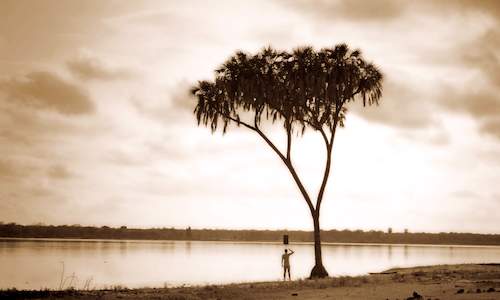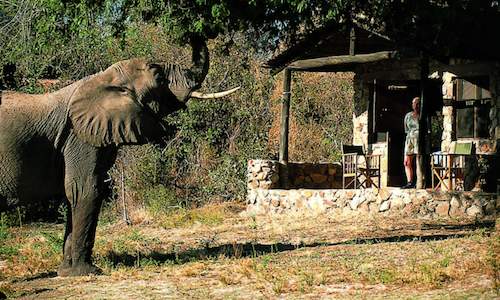Tanzania Safari Guide to Ruaha
Ruaha National Park is all about wilderness, spectacular scenery and wildlife. Due to its remote location, Ruaha National Park is largely unexplored making it a unique Tanzania safari experience.Access
Ruaha National Park is 120 km from the nearest town, Iringa, and the drive takes approximately two hours. Dar es Salaam to Ruaha is 600km, which is a ten hour drive.
Airport
For the flexibility and convenience for guests there are scheduled and/or charter flights from Dar es Salaam, Selous, Serengeti, Arusha, Iringa and Mbeya.
Highlights
- See the world's largest herds of Buffalo
- Possibly spot the endangered African Hunting Dog
Activities
- Game drives
- Fly camping
- Bush walks
Ruaha Landscape
Ruaha's dramatic scenery includes rolling hills, large open plains, groves of baobabs and the wide Great Ruaha River. Ecosystems in Ruaha National Parks represent a transition zone between the Miombo woodlands common in Southern Africa and the open savannah biomes, typical of northern Tanzania and Kenya. The park is dominated by the Ruaha River and its tributaries, which provide much needed water during the dry season.
Climate
The climate has a balmy tropical climate. The best time for game viewing is during the dry season which is from mid May to December. The wet season is from January to April, and this is when the scenery is at its most lush and is a great time for seeing wildflowers and the regions abundant birdlife.
The Ruaha Safari Experience
Picnic at Jongomero Camp
Ruaha is the second largest park in Tanzania (10,300 sq km or 3,980 sq miles), and its name is derived from the Great Ruaha River which is the main feature of the park, drawing thousands of animals to its waters in the dry season. With herds of more than 10,000 Elephants, vast concentrations of Buffalo, Gazelle, many predators and over 400 bird species, Ruaha offers travellers an unforgettable safari on Tanzania's southern circuit. Ruaha Park is also known for the stately Sable and Roan antelopes and rich bird life.
An extensive and well maintained network of game-viewing roads follows the Great Ruaha River and its seasonal tributaries. Travellers will rarely meet any other vehicles on game drives; giving visitors a feel of a private safari adventure.
Game Viewing in Ruaha
Large predators - Lion, Leopard, Cheetah, Hyena and African Wild dog, stalk the Ruaha savannah. Ruaha National Park has the largest Elephant population of any Tanzanian national park and plenty of Buffalo, Zebra and Giraffe are seen. Ruaha's high diversity of antelope includes Lichtenstein's hartebeest, Defassa waterbuck, Impala, Grant's gazelle, lesser and greater Kudu, sable and roan antelope.
Game drives
Game drives are taken in specially adapted open 4 wheel drive vehicles, led by an experienced guide and driver. A packed picnic lunch can be taken on a full day game drive. The roads in the park are all weather roads and remain open all year round. There is no off road driving or night driving allowed in Ruaha National Park.
Fly-camping
Fly camping excursions can be taken from the various lodges. Guests will 'bush camp' in their own private camp in special camping sites selected according to seasonal game movements. Daily game drives and walks are done from the camp. Accommodation is usually in dome tents with a separate toilet and bucket shower.
Bush walks
Bush walks are a wonderful way to truly experience the varied landscape of the Ruaha National Park. Guests will be led by an expert guide who will teach them to read the signs of the bush and track animals. The experience focuses on the smaller animals and plants that are often overlooked on a game drive. Large predators are seldom encountered although, Elephant are often seen.
Birding in Tanzania
Due to Ruaha's geographical location, the park is visited by northern and southern migrants, but also has a great variety of resident bird species. Over 400 species of birds have been recorded. Along the rivers bird watchers will find goliath herons, saddle-billed storks, white-headed plovers and the white-backed night heron. There are six species of vultures and hornbills, and raptors abound.
When to go
The best time to see predators and large mammals is during the dry season (May-December) when wildlife converges on the dwindling water reserves and concentrates along the Great Ruaha River. Bird-watching, lush scenery and wildflowers are best experienced during the wet season (January-April). Walking safaris operate during the dry season (May-December).
Go on a
Ruaha National Park safari in Tanzania

Tanzania is seeing the benefits of tourism and, with many African safari travelers looking for new destinations, Ruaha is beginning to fulfi...
more
Ruaha National Park in Tanzania is one of the new frontiers of African safari travel, a place where species overlap in their range and where...
more



 Tanzania is seeing the benefits of tourism and, with many African safari travelers looking for new destinations, Ruaha is beginning to fulfi...
Tanzania is seeing the benefits of tourism and, with many African safari travelers looking for new destinations, Ruaha is beginning to fulfi... Ruaha National Park in Tanzania is one of the new frontiers of African safari travel, a place where species overlap in their range and where...
Ruaha National Park in Tanzania is one of the new frontiers of African safari travel, a place where species overlap in their range and where...